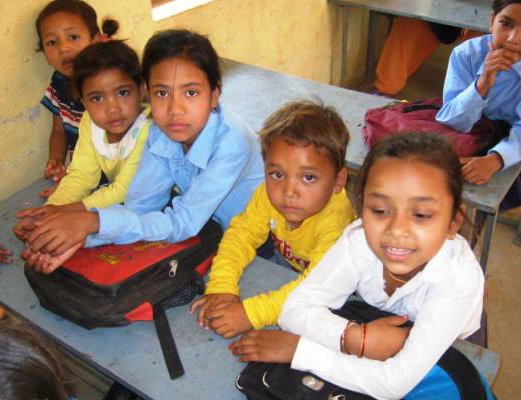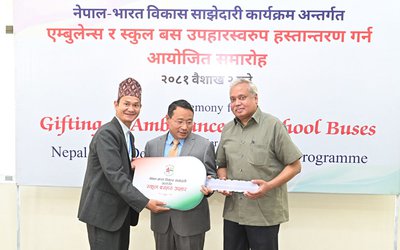
Puja Achhami,13, is among the lucky lots of students who could start their classes soon enough after the earthquakes of April and May last year left many schools in the lurch.
“I am very lucky that my school built new classrooms after the earthquake,” said Achhami, who studies at Shree Jwalamukhi Lower Secondary School, at Khanikhola, in Naubise Village Development Committee, of Dhading. "Our teachers tell us the new buildings are earthquake-proof."
The big earthquake of April 25, 2015 had destroyed an old building of the school and caused cracks in another, making the two-storey structures unusable for classes.
Japan International Cooperation Agency (JICA), under the Emergency Rehabilitation of Schools, provided a grant aid to build two classrooms. The construction work started in August 12, 2015 and completed in about two months.
The cost of the new steel frame structure was US dollars 14,600. The two classrooms are now used by 146 students, including Achhami, who otherwise would be missing classes.
The school used the classrooms and a temporary shed by placing students of as many as four different grades in a room for eight months.
“You see, the old building cracked and got a red sticker," said Tulshi Prasad Adhikari, headmaster of the school. "Construction of these rooms in a short period greatly helped our children coming from the poor communities who cannot afford for private school education.”
Teachers, parents and students of Shree Indrayani Lower Secondary School of Bairani Pinda, 50 kilometers west of Kathmandu, also have a reason to rejoice as the rehabilitation of two classrooms by JICA helped them to resume the classes in time.
Following the damage by quakes in the main school buildings and other classrooms, the school started its classes in the open space and later moved to temporary shelters.
"After the construction of the two rooms in the scheduled time, we could start normal activities. Although the space is still not enough to adjust 214 students, our students don’t have to study outside under the heat of the Sun,” said Suraj Shrestha, the school principal. “This is a great gift given by the Japanese government to the people of our village at our time of dire need.”
The four classrooms of the two schools were built under the partial aid of Japan, which provided only the construction materials for both the schools.
“At a time when most of the people had lost everything, including their houses, with hardly anything left to support the construction of school buildings, JICA’s support was a blessing for us as we were able to send our children to schools soon hoping for their bright future after the lost hopes,” said Bhola Bhandari, a member of the school management committee. “When the situation was normal, the community would contribute some money to construct the school buildings.”
The new classrooms are also a boon because the admission time is beginning now. “Two more rooms mean four more classes for forty students as we have Been running classes for students of two grades in the one room. Earlier, we placed students of four grades in a room,” said Sharashwati Khatiwada, primary school teacher of Indrayeni Lower Higher Secondary School. "Along with JICA, United Mission to Nepal is also supporting us to construct two classrooms.”
Under the school rehabilitation program, Japan provided 2 million US dollars for Dhading, Nuwakot and Gorkha districts. Under this program, 30 classrooms have already been rehabilitated out of 184. The project will be completed by June 2016.
The Japanese government has provided 0.9 million USD to rehabilitate 110 classrooms. Thirty classrooms have already been rehabilitated and the rehabilitation work of 44 other schools are underway. However, the rehabilitation of thirty-six classes is yet to be started.
Japan has also provided a loan assistance of 112 million dollars under the emergency school reconstruction project 2015 August-2019 August. Co-financed by the Asian Development Bank, this project will cover Dhading, Gorkha Nuwakot, Rasuwa, Makwanpur and Lalitpur districts.
Out of 30,000 classrooms destroyed by April and May 2015 earthquakes, the new earthquake resistant classrooms mean something only the lucky students and teachers are getting to use.
JICA is also implementing the emergency project Rehabilitation and Recovery From Nepal Earthquake (RRNE), July 2015 to July 2017. The objectives are to support earthquake affected population without delay through recovering public service, income generation of the people. Under the project, JICA will reconstruct local public facility and provide livelihood support for earthquake affected people of Gorkha and Sindhupalchwok.
Focusing on different areas, JICA has agreed to provide Nepal approximately 260 million USD for earthquake recovery. The areas covered include reconstruction of rural housing, schools, hospitals and infrastructure, resilient development plan for Kathmandu Valley, reconstruction plan for Gorkha and Sindhupalchwok and quick impact projects to restore small public facilities and improve livelihood of earthquake victims.
JICA in Chautara
Ruined by earthquakes, the transmission pipes of Chautara’s Jugal Yalkharak Holche Drinking Water Project caused disruption in the drinking water supply for over 50,000 residents of Chautara and three other villages of Sindhupalchowk district. JICA is now providing 673 million rupees to replace the damaged water transmission pipelines.
“We can rebuild our houses and manage our means of livelihood. However, we don’t have any resources to repair the drinking water project which is a lifeline for over 40,000 people,” said Subhash Karmacharya, chairman of Water Users' Group.
“Although the water pipeline was temporarily restored following 15 days of disruption, it is at risk as the transmission line is old and damaged by earthquake,” said Sambhuraj Khanal, Engineer of Sindhupalchwok District Drinking Water and Sanitation Division. “This project, starting from end of April, will be completed in one and a half years replacing 22 kilometers of old pipelines.”
As the earthquakes damaged the building of the Office for Children and Women of Chautara, the services it was providing were badly affected. Under the ongoing Quick Impact Project, the recovery of social service and welfare for women and children is going on with a fund of 10 million Nepalese Rupees that JICA is spending to build back the office facility.
“With the destruction of the old building, the services delivered to women and children, including the shelters, was badly affected. As JICA has taken the responsibility to construct the building, women and children may get services soon,” said Sandhya Singh, Women Development Officer of Children and Women Development Office.
External support for the earthquake damaged buildings of the district agriculture office and other infrastructures in Sindhupalchwok has also been important in the building back better process.
JICA in Livelihood
Taradevi Shrestha, 25, of Ikhu village Development Committee of Sindhupalchowk is happy to join a one-day vegetable cultivation training for women. Along with Taradevi, 40 other women from the area joined the training conducted by District Agriculture Development Office (DADO), JICA and Good Neighbors, an INGO.
“As earthquakes had destroyed our crops and stored seeds of vegetables and other crops, through this training, I learnt how to produce nutritional vegetables in my garden and backyard,” said Taradevi. “ I am confident now that we can produce enough vegetables in our garden using the waste water and sell the surplus to nearby market.”
Along with supporting infrastructure, JICA is also supporting improvement of vegetable farming practices for women’s groups with an aim to increase the production of vegetables in home gardens through the improvement of vegetable production skills of women and to ensure food security with home grown food at the times of disaster.
The livelihood program will also benefit the people of Talamarang, Bansbari, Mangkha, Maneshwara and Thokarpa village of Sindhupalchowk district. JICA is also launching similar programs in Gorkha district as well.
“Home gardens can produce sufficient vegetables using the waste water to irrigate the garden,” said Sakanura, a JICA consultant, who came all along from Japan to Sindhupalchwok. “ People require nutrition and vegetables can produce it.”
As earthquakes damaged houses, farms, and seeds, JICA is also supporting seeds storage facility for District Agriculture Development Office under its impact project.
“We are working closely with JICA to increase the production of improved seeds with good quality and to contribute to the food security of the community,” said Hem Sharma, senior agronomist at the District Agriculture Development Office Sindhupalchwok. “With Support from JICA, we are launching training targeting women of poor farmers to improve knowledge and skills on the cultivation skills.”
As Nepal is celebrating a year since the earthquake, JICA has shown how intervention in schools, infrastructure and agriculture can bring a change so people can return to a normal life.
“Japan has been supporting Nepal in various sectors in the earthquake recovery process with other development partners. Our contribution is aimed at helping Nepal build back better,” said Japanese ambassador to Nepal Masahi Ogawa. "From the very beginning of earthquake devastation, Japanese government has been supporting Nepal through different programs.”
As JICA is working closely with the government’s priority projects, there is a sense of ownership of local government offices, local bodies and communities in JICA’s projects.
“JICA’s efforts are in line with the government’s efforts. We proceed with the priority of Nepal government. We hold a series of discussions with the stakeholders before any rehabilitation and reconstruction project. We want quick impacts,” said Sakuma Jun, chief representative of Japan International Cooperation Agency Nepal Office.
Although the earthquakes badly damaged some parts of Japan this week killing almost a dozen people and damaging infrastructure, Japan has shown a sincere commitment to supporting Nepal's earthquake recovery endeavours.
“Back home, we are in a very difficult time with a series of earthquakes hitting us. We want to see our contribution should transform the livelihood of poor people,” said Uichiro Nakano, first secretary of Embassy of Japan.
As Nepal and Japan have been celebrating 60 years since the establishment of their bilateral relations, the immediate support provided by Japanese government through Japan International Cooperation Association (JICA) in earthquake hit areas will be worth remembering for a long time to come.
Reporting from Bairani and Chautara

Keshab Poudel
Poudel is the editor of New Spotlight Magazine.
- ECONOMY: Growth At 3.3
- Apr 16, 2024
- DPM’s SHRESTHA’S CHINA VISIT High Profile, Low Key
- Apr 14, 2024
- Maha Kumbha In Barahkshetra: A Sacred Festival In Sacred Koshi (Kaushiki) River
- Apr 09, 2024
- LOSS AND DAMAGE: Upper Tamakoshi A Case
- Apr 02, 2024
- Helvetas-Nepal’s InElam Promoting Herbal Oil In Sarlahi
- Mar 31, 2024
















